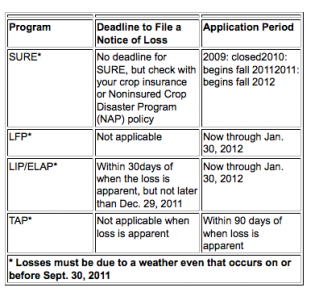Farm Disaster Assistance Deadlines From USDA FSA
FSA Reminds Producers of Farm Disaster Assistance Deadlines
The U.S. Department of Agriculture’s (USDA) Farm Service Agency (FSA) Administrator Bruce Nelson reminded producers today about upcoming deadlines for disaster assistance. Nelson emphasized that losses must be the result of a weather event occurring on or before Sept. 30, 2011.
“This year brought a host of extreme weather challenges for America’s farmers, ranchers and producers,” said Nelson. “USDA is committed to use the resources at our disposal to reduce the impact of these conditions and help producers get back on their feet. And this year, especially, it’s important for producers to be aware of program deadlines and to have their records in order so that they get the assistance they need.”
The 2008 Farm Bill authorizes coverage of disaster losses through these five programs:
Supplemental Revenue Assistance Payments Program (SURE); Livestock Indemnity Program (LIP); Emergency Assistance for Livestock, Honey Bees, and Farm-Raised Fish (ELAP); Livestock Forage Disaster Program (LFP); and the Tree Assistance Program (TAP). SURE applications for 2010 crop losses will be accepted later this fall. SURE applications for 2011 crop losses will be accepted in the fall of 2012, when the 2011 farm revenue data required by statute becomes available. FSA is required to determine that the claimed loss was because of a disaster occurring on or before Sept. 30, 2011. FSA must determine if a qualifying loss meets the established disaster relief criteria for at least one crop. At the time the SURE application for payment is filed, the producer will be required to identify and certify a crop of economic significance that suffered a qualifying loss of 10 percent or more. At least one such crop with 10-percent losses on or before Sept. 30, 2011, is required by SURE.
“We encourage all producers to read the applicable disaster program fact sheets and visit their local FSA county office. The staff can provide additional information such as the deadline for filing a program application or the initial requirement for filing a notice of loss,” Nelson said.
Important dates for the five disaster programs are summarized in the table here: 
Fact sheets for these programs can be found at www.fsa.usda.gov; click on Newsroom, then Fact Sheets.
Additional information regarding the programs is at https://disaster.fsa.usda.gov.
And be sure to check out the following links with info about how to deal with flooded crops:
FloodsHurricanesPowerOutages/ucm112723.htm
https://www.fda.gov/RegulatoryInformation/Legislation/FederalFoodDrugandCosmeticActFDCAct/FDCActChapterIVFood/ucm107527.htm
And these links about helping or receiving help for flooded farms in Vermont:
1) The Vermont Community Foundation and Agency of Agriculture have built the *Vermont Farm Disaster Relief Fund* to help farmers through the current crisis https://www.vermontcf.org/give-now
2) Pete’s Greens and the Center for an Agricultural Economy have also established a fund – To make a tax deductible donation, please visit https://hardwickagriculture.org/donate.html to donate online or write a check to the Vermont Farm Fund and mail to the Center for an Agricultural Economy, PO Box 451, 41 S. Main St., Hardwick, VT 05843
3) The Intervale has also set up a relief fund for Intervale growers. The fund will be used by farmers to compensate for crop losses and equipment damage. To make a tax-deductible donation, please donate online at *www.intervale.org. After you choose the amount you’d like to give, you can designate your contribution to the *”Intervale Center Farmers Recovery Fund.”* Or, mail your donation to Intervale Center, 180 Intervale Road, Burlington, VT 05401. Please make your check payable to “Intervale Center Farmers Recovery Fund.”



 Your Privacy Choices
Your Privacy Choices
Leave a comment